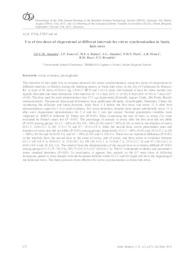Use of two doses of cloprostenol at different intervals for estrus synchronization in Santa Inês ewes.
Use of two doses of cloprostenol at different intervals for estrus synchronization in Santa Inês ewes.
Author(s): ALMEIDA, S. F. C. M.; FONSECA, J. F. da; BALARO, M. F. A.; ALMEIDA, J. G.; PINTO, P. H. N.; MOURA, A. B.; ROSA, R. M.; BRANDÃO, F. Z.
Summary: Abstract: The objective of this study was to compare protocols for estrus synchronization, using two doses of cloprostenol in different intervals, in Martch, during the breeding season, in Santa Inês ewes, in the city of Cachoeiras de MacacuRJ. A total of 30 ewes (43.9±6.4 kg, 2.9±0.27 BCS and 3.4±1.6 years old) weaned at least for three months was equally allocated into three treatments, with intervals of: 11.5 days (G11.5: n=10), 9 days (G9: n=10) or 7 days (G7: n=10). The dose used for each administration was 37.5 µg cloprostenol (Estron®, Agener União, São Paulo, Brazil) intramuscularly. Transrectal ultrasound evaluations were performed (B-mode; SonoScape®, Shenzhen, China) for monitoring the follicular and luteal dynamic, daily from 5 d before the first dose, and every 12 h after both administrations, again for 5 d or until ovulation. For estrus detection, females were teased individually every 12 h after each cloprostenol administration for 5 d and for 5 min per animal. Normal quantitative variables were subjected to ANOVA followed by Tukey test (P<0.05). Data concerning the rate of ewes in estrus (%) were evaluated by Fisher's exact test (P <0.05). The percentage of animals in estrus after the first dose did not differ (P>0.05) among groups: G11.5 60% (6/10); G9 80% (8/10) and G7: 80% (8/10) as well as the duration of estrus (G11.5: 24.0±13.1 h; G9: 37.5±7.7h and G7: 28.5±11.0 h. After the second dose, estrus presentation rates and duration of estrus also did not differ (P>0.05) among groups, respectively: G11.5 90% (9/10) and 29.3±12.2 h; G9 ? 100% (10/10) and 36.0±10.4 h; and G7 80% (8/10) and 31.5±8.9 h. There was no statistical difference (P>0.05) in the intervals from the second dose to the onset of estrus, end of estrus, and from estrus to ovulation between G11.5 (48.5±8.9 h; 80.0±8.5 h; 35.0±20.1 h), G9 (50.3±13.1 h; 83.0±9.1 h; 25.5±12.2 h) and G7 (36.5±6.2 h; 68.0±14.0 h and 20.3±6.1 h). The interval from the administration of the second dose to ovulation differed (P<0.05) among groups G11.5 (78.7±9.4 h), G9 (75.5±8.3) h e G7 (56.8±6.2 h). The G7 anticipated ovulation and presented a lower standard deviation (P<0.05). In conclusion, it appears that animals in the G7 were close to follicular dominance period or were already with the dominant follicles while G11.5 and G9 might still be in the beginning of the follicular wave. The three protocols were effective for estrus synchronization in Santa Inês ewes.
Publication year: 2015
Types of publication: Abstract in annals or event proceedings
Unit: Embrapa Goats & Sheep
Observation
Some of Embrapa's publications are published as ePub files. To read them, use or download one of the following free software options to your computer or mobile device. Android: Google Play Books; IOS: iBooks; Windows and Linux: Calibre.
Access other publications
Access the Agricultural Research Database (BDPA) to consult Embrapa's full library collection and records.
Visit Embrapa Bookstore to purchase books and other publications sold by Embrapa.

